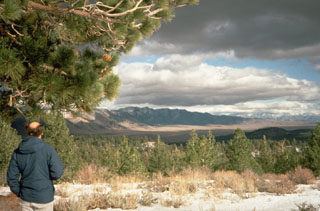Report on Long Valley (United States) — December 1982
Scientific Event Alert Network Bulletin, vol. 7, no. 12 (December 1982)
Managing Editor: Lindsay McClelland.
Long Valley (United States) Earthquake swarms and increased thermal activity
Please cite this report as:
Global Volcanism Program, 1982. Report on Long Valley (United States) (McClelland, L., ed.). Scientific Event Alert Network Bulletin, 7:12. Smithsonian Institution. https://doi.org/10.5479/si.GVP.SEAN198212-323822
Long Valley
United States
37.7°N, 118.87°W; summit elev. 3390 m
All times are local (unless otherwise noted)
The following is from the USGS.
"Earthquake swarms in the Long Valley area resumed in mid-December, after quiescence that lasted through most of November. On 14 December between 0056 and 0200, 200-300 small events were recorded, of which only about ten could be located. These were centered at 2-3 km depth in the S part of the caldera, in the Casa Diablo epicentral area of many previous swarms. Spasmodic tremor was recorded for the first time since the 7-8 May swarm. Increased thermal activity was noted along Hot Creek and near the epicentral area a few days before this swarm. Geyser-like activity at one Hot Creek vent occasionally ejected hot water to about 10 m height and water from another vent surged intermittently to about 1.5 m height.
"On 21 December at 1428, two M 3.3 earthquakes occurred at 6 km depth in the same epicentral area and were followed by a series of aftershocks. On 22 December between 2140 and 2200 about 100 events were recorded outside the caldera near Red Cones, two basaltic cinder cones about 9 km SW of the 14 and 21 December epicenters. Spasmodic tremor also accompanied this brief swarm.
"On 6 January at 1623, the most intense and prolonged swarm of earthquakes since May 1980 began in the S moat of the caldera. During the first 12 hours, more than 1,000 events were recorded, most in the Casa Diablo epicentral area, but with a secondary concentration near the caldera wall at Convict Creek (about 10 km ESE) and with many distributed between. Strong spasmodic tremor was nearly continuous during the first 12 hours. Two particularly strong shocks, M 5.5 and 5.6 at 1738 and 1924, caused minor damage in Mammoth Lakes and disrupted electrical and telephone service for about an hour.
"During the first 36 hours, earthquakes of magnitude greater than or equal to 1 were occurring at a rate of 80-100/hr, those of magnitude greater than or equal to 3 at 1-5/hr. During the succeeding 36 hours, the number of earthquakes gradually declined to about 15/hr. Sporadic events of M 3-3.5 continued through 1200 on 10 January. As of 12 January, recorded events were continuing at a rate of 4-5/hr, still above the normal background of about 50/day. Hypocenters during the swarm ranged from 10 km to less than or equal to 3 km depth, with most between 4 and 7 km.
"Deformation (borehole tiltmeter, dry tilt, and geodimeter) measurements made during the swarm on 10-11 January suggest that uplift of the resurgent dome accompanied the swarm, but the exact amount awaits completion of remeasurement of selected parts of the leveling network. This, together with the concentration of seismicity in the S moat and the absence of significant seismicity in the Sierra block S of the caldera during this swarm, strongly suggests that the swarm was associated with magma movement at depth. Reoccupation of the geodimeter network in early December had shown no apparent change in deformation since the previous measurements in August."
Geological Summary. The large 17 x 32 km Long Valley caldera east of the central Sierra Nevada Range formed as a result of the voluminous Bishop Tuff eruption about 760,000 years ago. Resurgent doming in the central part of the caldera occurred shortly afterwards, followed by rhyolitic eruptions from the caldera moat and the eruption of rhyodacite from outer ring fracture vents, ending about 50,000 years ago. During early resurgent doming the caldera was filled with a large lake that left strandlines on the caldera walls and the resurgent dome island; the lake eventually drained through the Owens River Gorge. The caldera remains thermally active, with many hot springs and fumaroles, and has had significant deformation, seismicity, and other unrest in recent years. The late-Pleistocene to Holocene Inyo Craters cut the NW topographic rim of the caldera, and along with Mammoth Mountain on the SW topographic rim, are west of the structural caldera and are chemically and tectonically distinct from the Long Valley magmatic system.
Information Contacts: R. Bailey, USGS, Reston, VA; R. Cockerham, USGS, Menlo Park, CA; F. Riley, USGS, Denver, CO.

